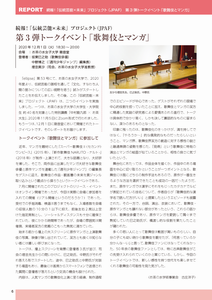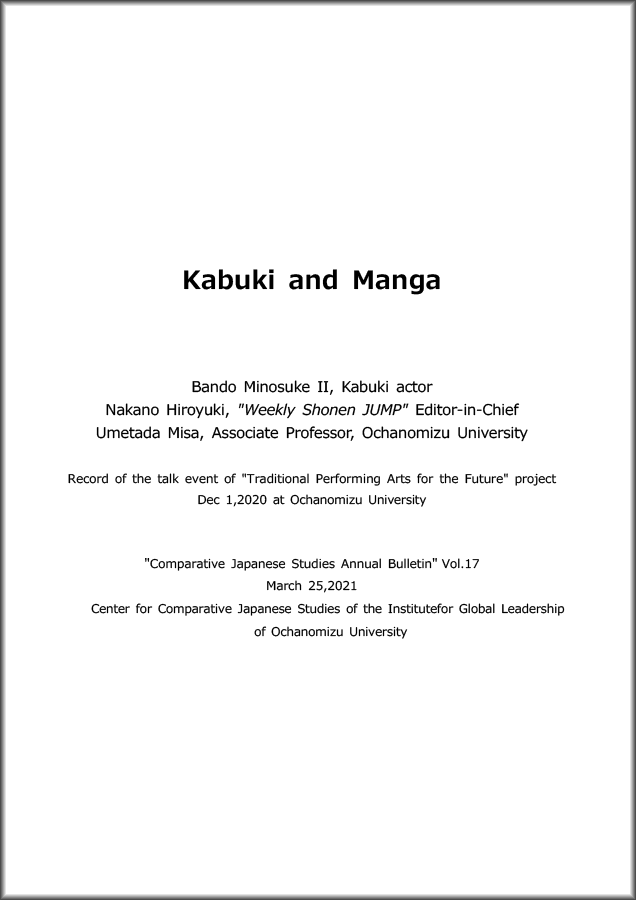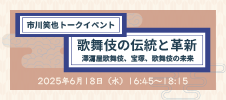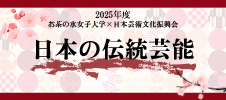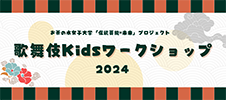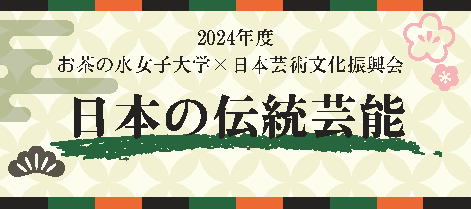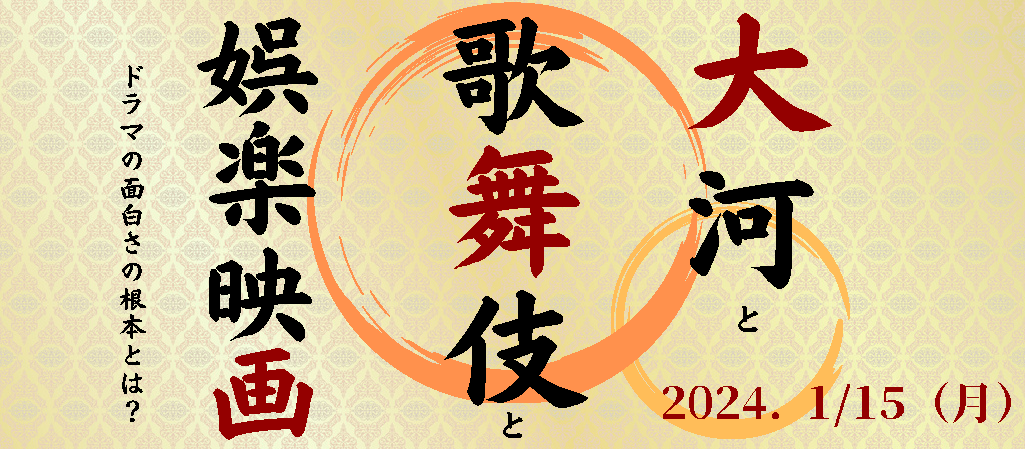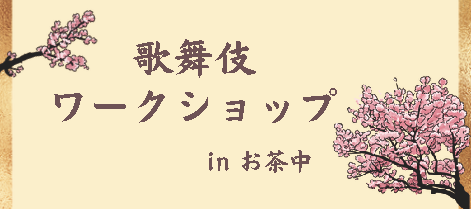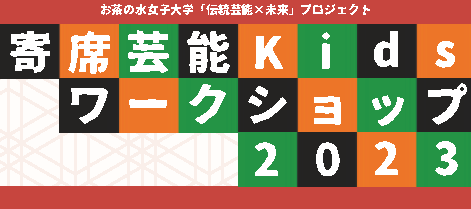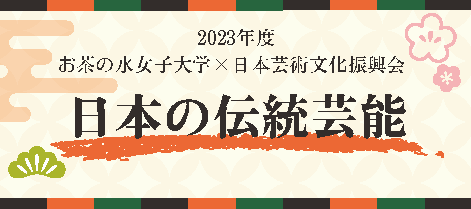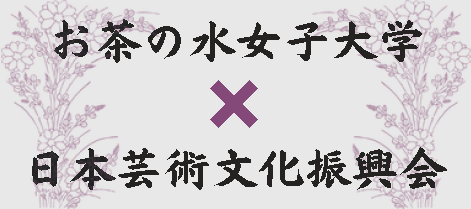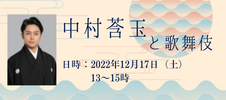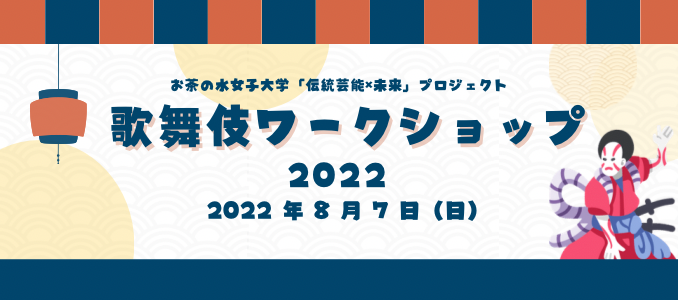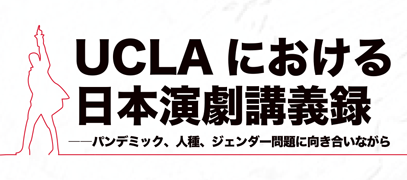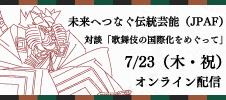- 「伝統芸能×未来」プロジェクト(JPAF)
- イベントレポート
- イベントレポート トークイベント「歌舞伎とマンガ」(Japanese/English)
ページの本文です。
イベントレポート トークイベント「歌舞伎とマンガ」(Japanese/English)
2021年4月27日更新

坂東巳之助さん

中野博之さん

壇上の様子
You can find the English version at the bottom of this page.
2020年12月1日(火)に歌舞伎俳優の坂東巳之助さんと『週刊少年ジャンプ』編集長の中野博之さんをゲストにお迎えしてトークイベント「歌舞伎とマンガ」を開催しました。コロナ対策のため会場定員1200名に対し参加者150名とし、距離を保ちながらの開催となりましたが、歌舞伎とマンガへの熱意と愛に溢れたゲストのお話によって実に濃密なイベントとなりました。
近年マンガ原作の演劇作品が数多く上演され、人気を博していますが、そうした流れは歌舞伎にも及んでいます。当イベントでは新たな時代の歌舞伎をマンガを通じて考えることを目指し、スーパー歌舞伎II『ワンピース』(2015年初演)と新作歌舞伎『NARUTO-ナルト-』(2018年初演)について、その制作の経緯をおうかがいするとともに、 上演によって浮かび上がった歌舞伎とマンガの親和性などについて話し合いました。上演にあたって両ジャンルの中心的な役割を果たしたお二方のお話は非常に刺激的で、歌舞伎の底力と、両ジャンルの創造のエネルギーを目の当たりとし、学生達は様々な気付きを得たようです。
ここでは学生3名と、『ellipse』54号(お茶の水学術事業会、2021年2月)所収のイベントレポートを掲載します(日本語のみ)。
当イベントの講演録(全文)を、『比較日本学教育研究部門 研究年報』17号(お茶の水女子大学グローバルリーダーシップ研究所比較日本学教育研究部門、2021年3月25日)に、その英訳を本ページ末尾に掲載していますので、どうぞご覧ください。
執筆者の所属・学年は開催当時
トークイベント「歌舞伎とマンガ」は、歌舞伎もマンガも好きな自分にとって、歌舞伎俳優の坂東巳之助さんと『週刊少年ジャンプ』編集長の中野博之さんから同時にお話を伺うことができる夢のような機会でした。
2015年から上演されたスーパー歌舞伎II『ワンピース』は、人気マンガと歌舞伎の融合ということでメディアでも大きく取り上げられ、当時中学生だった自分にとっても強く印象に残っています。イベントの中で、その『ワンピース』が、実は集英社とアニメ委員会の方たちの雑談から企画が始まり、松竹株式会社に話が持ち込まれたと聞き、非常に驚きました。雑談という漠然とした状態から、類似点はあるものの異文化である歌舞伎とマンガが一つの舞台として形になったのは、歌舞伎とマンガ双方の文化としての底力、またそれらを支える方々の努力によるものだと思いました。
また、新作歌舞伎『NARUTO-ナルト-』については、巳之助さんが主演をつとめられたということもあり、脚本や制作に関わるお話も伺うことができました。自分自身高校生の頃に劇場で観た作品だったので、その作品ができるまでのお話はとても興味深く、またそれをお二人の口から直接伺えることが嬉しかったです。
イベント当日は、座れる席を減らしていたり、質疑応答でGoogleフォームを利用していたりなど、空間において密が避けられていましたが、ゲストのお二人が話された約一時間半はとても濃密でした。歌舞伎とマンガの両方の側から話を伺い、それぞれの表現の幅広さや魅力を改めて感じることのできる充実した時間を過ごすことができました。
文教育学部 言語文化学科1年 五十嵐桃寧
このイベントで特に印象的だったのは、歌舞伎とマンガは親和性が高いというお話です。私はもともと、歌舞伎とマンガは組み合わせるには共通点がないように感じていましたが、歌舞伎の「見得を切る」という独特な演出がマンガの誇張表現とうまくかみ合ったというお話や、歌舞伎も『少年ジャンプ』のマンガもキャラクターが魅力であるというお話を聞き、思っていたよりも歌舞伎とマンガは相性が良いと気付かされました。
一方で、マンガを歌舞伎化する上でかみ合わない部分もあり、表現のすり合わせを何度も行ったというお話がありました。その中で印象に残っているエピソードがあります。スーパー歌舞伎II『ワンピース』の立ち回りでは、当初、従来の歌舞伎の表現方法にのっとりエドワード・ニューゲート(白ひげ)というキャラクターの背中を斬ってしまっていたところを、原作マンガに精通している巳之助さんの意見で、背中を斬らないように変更したというお話です。歌舞伎の伝統を残す部分と、マンガを再現する部分のバランスを取る難しさと、そのなかにおける巳之助さんのお力を感じました。
それに加えて、様々な題材を受け止める歌舞伎の懐の深さを知りました。アニメや実写映画、2.5次元ミュージカルなどの他のメディアミックスでは、マンガの忠実な再現が求められ、マンガと違う表現は違和感を持って受け止められる傾向にあると個人的には思っています。その一方、歌舞伎では隈取りや見得などの独特の演出はそのままに、キャラクターや脚本が作られていました。こういった演出がむしろ魅力として多くの人に楽しまれている点から、常に新しいものを取り入れて発展してきたという歌舞伎の特性を実感しました。
この度のイベントを通して、歌舞伎とマンガという新しいメディアミックスにおける表現の面白さを知ることができました。また、作り手の方々が影響を与え合ったり、新しいファン層の獲得につながっていたりと、マンガを原作としたこれらの演目が人のつながりを作る場にもなっていると知り、様々な面で歌舞伎とマンガのこれからの展開がとても楽しみになりました。
最後に、このイベントに参加できたことを心から嬉しく思います。巳之助さんと中野さんのお話から、歌舞伎とマンガへの熱意を強く感じ、生活を送る気力をいただきました。このたびは、貴重なお話をまことにありがとうございました。
文教育学部 言語文化学科 日本語・日本文学コース3年 及川慈子
私はもとよりマンガや伝統芸能に興味があり、このイベントを知り喜び勇んで参加したのですが、大変興味深いお話をいくつも聞くことができました。中でも、マンガと歌舞伎の親和性についてと、『NARUTO-ナルト-』の原作者・岸本斉史先生の感想が印象的でした。
まず、マンガと歌舞伎が一つの作品として融和できたのは、実は両ジャンルの世界観が本質的に似通っているからだという話が、巳之助さんと中野さん双方からなされました。歌舞伎の「見得」はよく考えると不自然で普通ならしないものですが、自然でかっこいいものとして受容できます。それは歌舞伎では、通常時であれば嘘臭くさえ見える不自然さが真実味を持つ世界観づくりがなされているからなのだそうです。『ジャンプ』作品も同じように、不自然なものが自然にとられるような、いわば「見得」を切り続けているような世界観の中で描かれている、だからこそ一見交わらないように思える歌舞伎に融和し、魅力的な作品として観客の記憶に残ったという指摘がなされました。なぜ『ONE PIECE』と『NARUTO』が、多くのマンガが行なっている2.5次元舞台ではなく、歌舞伎化という難しい試みに挑戦したのかという理由の核心に触れられたような気がしました。
もう一つ、岸本先生が、歌舞伎のナルトとサスケの戦いによる役者さんたちの実際の消耗具合を見たことで、「今このシーンを描いたらもっと違う描き方ができる気がする」と口にされていたという話をご紹介します。私は自分で話を書いたり小説やマンガを読みながら、実際どの程度動けば人間は消耗するのかと疑問に思うことがありました。命がけの戦いは自分で体験できるものでもなく、想像しきれない部分が多くあるはずです。そのため、プロの漫画家でも勝負における消耗は想像しきれないと感じていたこと、そして原作者にこうした形で歌舞伎がフィードバックされたことが印象的でした。また、今まではマンガ原作をきっかけに若者が歌舞伎を見るようになった等、歌舞伎側の利点にしか目を向けていませんでしたが、マンガにも影響があったという大きな気付きを得ることができました。
以上のような当事者のお話を通じて、多くの視点を得ることができました。私は歌舞伎化されると聞いた時、別の媒体で表現するリスクばかりが気になりましたが、例えば『ONE PIECE』のキャラクター〈白ひげ〉は逃げ疵を受けないからと、巳之助さんが歌舞伎の典型的な立ち回りとは異なる提案なさったというお話を聞き、これほどに作品愛を持った方たちの存在があったからこそ、多くの観客に愛される作品になったのだと感銘を受けました。作品を作り上げる方々の情熱や考えがひしと伝わってくるトークイベントで、色々と気付きを得ることができた貴重な経験となりました。
文教育学部 人文科学科 比較歴史学コース2年 中尾優李
Event Report: “Kabuki and Manga”
On Tuesday, December 1, 2020, we held a talk event titled "Kabuki and Manga," featuring Kabuki actor Bandō Minosuke and Weekly Shonen Jump’s editor-in-chief Nakano Hiroyuki as guests. In compliance with COVID-19 measures, the event took place with 150 participants in a venue with a capacity of 1,200 people to maintain social distancing. Thanks to the guests' passion and love for kabuki and manga, it was truly an enriching talk.
Recently, theatrical productions based on original manga have become increasingly popular, and the trend has also reached kabuki. The aim of the event was to consider this a new era of kabuki through manga. We discussed the production process of Super Kabuki II: One Piece (2015) and the new kabuki NARUTO (2018), as well as the affinity between kabuki and manga that emerged through these performances. Our guests played a central role on both sides of the production of these plays, and their discussion was highly stimulating. Students gained various insights by witnessing the profound strength of kabuki and the creative energy of both genres.
We present here the event report by three students, published in issue 54 of 'ellipse' (Ochanomizu Academic Association NPO)(September,2021)(in Japanese only).
Additionally, the lecture record of this event is included in the ' Comparative Japanese Studies Annual Bulletin 'Vol.17(March 25,2021)(Center for Comparative Japanese Studies of the Institute for Global Leadership of Ochanomizu University).
The English translation of it is provided below. Please take a look.
*Student’s affiliation and grade at the time of the event.
As someone who loves both kabuki and manga, the opportunity to hear from kabuki actor Bandō Minosuke and Weekly Shōnen Jump’s editor-in-chief Nakano Hiroyuki at the same time was like a dream come true. Super Kabuki II: One Piece, performed from 2015, was a fusion of the eponymous popular manga and kabuki, and it received widespread media coverage. I was still in middle school at the time, and it left a strong impression on me. During the event, I was very surprised to learn that the idea for One Piece actually started from a casual conversation between Shueisha staff and the anime committee, which was then brought to Shōchiku. I then thought it was thanks to the inherent power of kabuki and manga, as well as the efforts of the people supporting them, that such vague idea could develop into a performance bringing these different yet similar cultures together. We also heard Minosuke talk about his experience portraying the lead role in NARUTO, as well as stories about the script and the production. Since I watched the show in the theater when I was in high school, I was very interested to know how it was made, and I was happy to hear it directly from Minosuke and Nakano.
On the day of the event, seating was reduced to avoid crowding, and Google Forms was used for the Q&A session to maintain a safe environment, but the approximately one and a half hours that the two guests spoke were very rich. Listening to stories from both the kabuki and manga perspectives, I was able to spend a fulfilling time feeling the broad range and appeal of each form of expression anew.
Igarashi Momone
I was particularly struck by the discussion on the affinity between kabuki and manga. Initially, I felt that kabuki and manga had no common ground. However, after hearing about how kabuki’s mie resembled manga’s exaggerated expressions, and how the appeal of both kabuki and Weekly Shōnen Jump derives from their characters, I realized that they were very similar.
On the other hand, there were also parts that did not mesh well when adapting manga into kabuki, and adjustments were necessary. In Super Kabuki II: One Piece, for instance, the character Edward Newgate (Whitebeard) should have been hit in the back in order to follow the kabuki conventions. However, Minosuke, who is very familiar with the original manga, insisted they left his back unscathed. This story highlighted the difficulty in balancing and preserving kabuki tradition with the faithful reproduction of the manga, while also showcasing Minosuke's significant contribution.
Additionally, I learnt about kabuki’s openness to embrace a wide variety of subject. Media mixes like anime, live-action films, and 2.5.D musicals are required to be as close to the original manga as possible, hence different form of expression are perceived with discomfort. The One Piece and NARUTO plays preserved widely appreciated kabuki conventions such as the kumadori makeup and the mie when creating both characters and the script. At the same time, I really got a sense of the unique quality of kabuki, which has evolved by continuously incorporating new elements. Through this event, I was able to learn about the fascinating expression that can be achieved through the new media mix of kabuki and manga. I also learned that these manga-based performances are also a place for people to make connections, with creators influencing each other and leading to the creation of a new fan base. This has made me very excited to see how kabuki and manga will develop in many different ways in the future. Lastly, I am sincerely delighted to have participated in this event. From the talks by Minosuke and Nakano, I sense their strong passion for kabuki and manga, and I am truly grateful for the valuable insights shared.
Oikawa Shigeko
I have always been interested in manga and traditional performing arts; hence I was delighted to attend the talk. I was particularly impressed by the discussion about the affinity between manga and kabuki, as well as the impression of NARUTO’s creator Kishimoto sensei. We heard both Minosuke and Nakano talk about how this fusion of manga and kabuki in the same performance was possible because these two genres share the same worldview. Kabuki’s mie is an unnatural movement that you would not normally make, but it looks cool. In the kabuki universe, what is unnatural or farfetched become verisimilar. The same happens in the JUMP manga universe, where characters are “continually striking mie” so to speak.
This is how manga could come together with kabuki to create a memorable work. The speakers touched on the core reasons why they chose the challenging task of turning One Piece and NARUTO into kabuki rather than a 2.5D musical. Additionally, we heard that, if Kishimoto sensei was to redraw the fight scene between Sasuke and Naruto, he might do things differently after seeing the exhaustion of the kabuki actors on stage. While writing stories, and reading manga and novels, I have wondered how much it takes for someone to reach a state of exhaustion. Since I can’t experience a life-or-death battle, there are many things I can’t imagine. I was struck by the fact that even a professional manga artist could not capture such exhaustion, yet it was kabuki which provided him with the necessary tools to fully comprehend it. I also realized that these performances did not only benefit kabuki by generating a new younger fanbase, as I initially thought, but also manga. I was able to gain many new perspectives. When I heard that these manga were going to be made into kabuki, I could only think about the risks of adapting it to a different media. For instance, when Minosuke said that not to hurt White Beard in the back because he doesn’t suffer any “cowards’ wounds”, he was suggesting something that differed from traditional tachimawari. I was deeply moved, realizing that it was precisely because of the presence of people who held such love for the work that it became a piece loved by many audiences. At the talk event, where the passion and thoughts of the creators of the work were strongly conveyed, I gained various insights, making it a valuable experience.
Nakano Yuri





